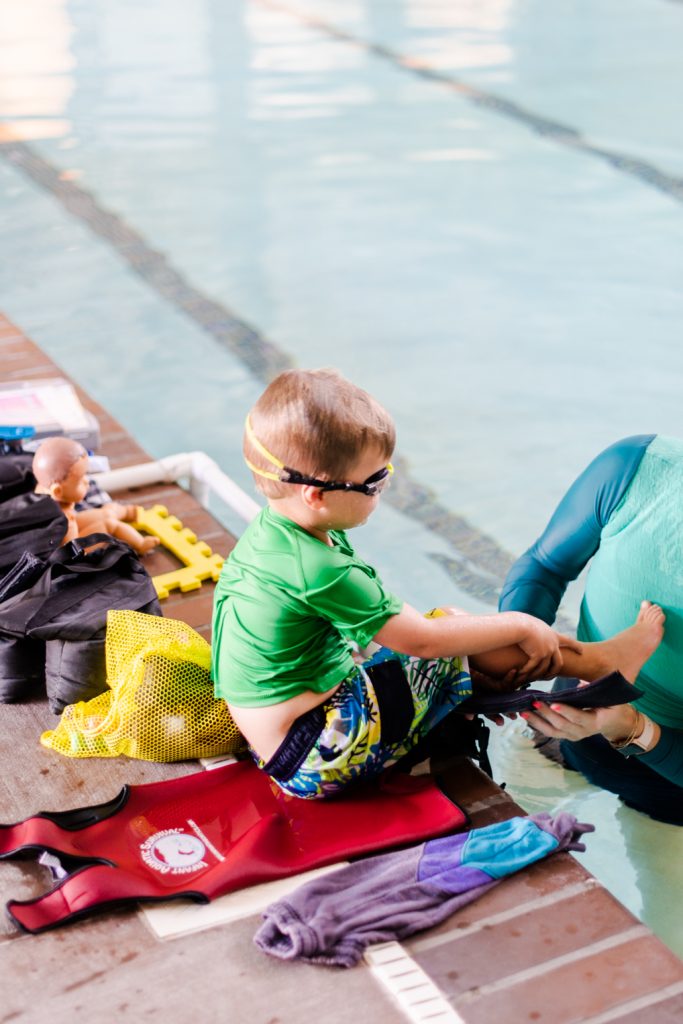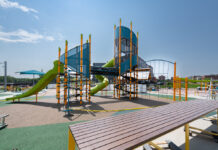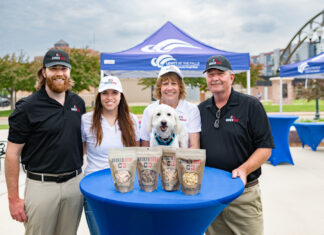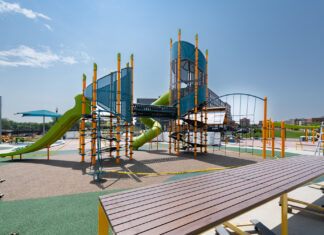Imagine an infant in water with no floating devices, knowing how to use breath control, roll over, and float to self-rescue themselves in any depth of water.
That’s what Andrea Oswald’s program, Float On, teaches children starting at 6 months old. “It’s such an amazing moment when they finally get it,” she said. “But what’s what makes this job so fun.”
“It’s such an amazing moment when they finally get it,” she said. “But what’s what makes this job so fun.”
Oswald is the only certified Infant Aquatics Specialist (IAS) in the state, and only a year into teaching, she’s taught over 100 kids since starting her program in January of 2018 in the Dow Rummel Village indoor pool in Sioux Falls.
She grew up in a small town in Nebraska, and after graduating from Augustana University, she nannied in Colorado where she took her two kids to an infant aquatics class. “I thought they would splash around for a bit… but no, within the first day they were learning how to hold their breath and going underwater and not to panic,” said Oswald.
“I thought they would splash around for a bit… but no, within the first day they were learning how to hold their breath and going underwater and not to panic,” said Oswald.
A few years later, founder of The Infant Aquatics Network Judy Huemann encouraged Oswald to take the training knowing how much she loved swimming and working with kids. On her first day of training, Oswald was already working with an infant, and after six weeks of intensive training, she became a certified instructor.
TIPS FOR PARENTS
> Any type of water safety you’re able to teach your child is a first step forward preventing drowning. Check with your local pool to see what types of programs they offer.
> Talk to your pediatrician about the right age for your child to start swimming lessons to receive the most current information on recommendations.
> Do your homework on what type of swimming program is right for you.
> Don’t be afraid of the cost, because learning how to swim can’t wait. Instead, take control of your child’s safety.
“I love the quote: don’t rescue your child from a challenge, teach them how to face it,” she said.
That’s the goal for each child who goes through the program: to be able to self-rescue in a drowning situation. For a child 6 months to walking, they learn to do a survival float, and once they can walk, Oswald teaches them how to swim with a float and kicking sequence.
Her swimming lessons are private one-on-one sessions. For infants 6-12 months, each session is 10 minutes a day for 24 sessions. Infants must be able to roll over onto their back before starting the program. After six seeks, they learn breath control, kicking and motor development, floating, swim sequences, and not to panic. In the last week of the program she tests their abilities through different scenarios, including dressing them in a snowsuit before falling into the water to ensure they’re able to self rescue.
After six seeks, they learn breath control, kicking and motor development, floating, swim sequences, and not to panic. In the last week of the program she tests their abilities through different scenarios, including dressing them in a snowsuit before falling into the water to ensure they’re able to self rescue.
“It’s really cool when the parents see what they’re able to do and realize, this is totally worth it,” she said.
When Oswald started Float On, her goal was to teach 20 kids in her first year and instead has taught over triple of that. Currently she continues having more parents wanting to enroll their child than she’s able to keep up with. Since each lesson is one-on-one, Oswald is able to tailor each class to the child.
Since each lesson is one-on-one, Oswald is able to tailor each class to the child.
“I put all my heart and soul into each kid, and I’ve worked with kids for so long that I know how different each child is,” she said.
Every child Oswald has taught has successfully completed the program, equipping them with life-saving survival skills, confidence, along with a little more peace of mind for their parents.
FOR MORE INFORMATIONS, VISIT INFANTAQUATICS.COM OR FACEBOOK.COM.

















